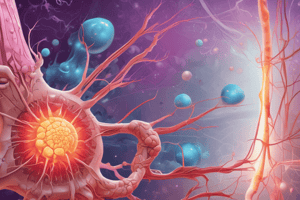Podcast
Questions and Answers
Which mechanism facilitates communication between cytokines and the brain, according to the passage?
Which mechanism facilitates communication between cytokines and the brain, according to the passage?
- Direct injection of cytokines into the cerebrospinal fluid.
- Active transport of all cytokines across an intact blood-brain barrier.
- Passive diffusion in areas of blood-brain barrier deficiency. (correct)
- Exclusive binding of cytokines to opioid receptors in the brain.
How does inflammation affect glucocorticoid receptor (GR) sensitivity, according to the passage?
How does inflammation affect glucocorticoid receptor (GR) sensitivity, according to the passage?
- Inflammation enhances GR sensitivity by promoting receptor upregulation.
- Inflammation increases GR sensitivity by preventing receptor degradation.
- Inflammation has no direct effect on GR sensitivity.
- Inflammation reduces GR sensitivity through cytokine signaling pathway interaction. (correct)
What is the consequence of excessive cytokine production in animal models exposed to stress?
What is the consequence of excessive cytokine production in animal models exposed to stress?
- Decreased production of nitric oxide.
- Diminished neurotropic support and reduced neurogenesis. (correct)
- Improved oxidative status in the central nervous system.
- Enhanced neurotropic support and increased neurogenesis.
How does neuroinflammatory activation contribute to the neuropathophysiology of depression, according to the passage?
How does neuroinflammatory activation contribute to the neuropathophysiology of depression, according to the passage?
According to the passage, how does inflammation modulate the serotonergic system to induce depressive symptoms?
According to the passage, how does inflammation modulate the serotonergic system to induce depressive symptoms?
What is the role of the enzyme IDO in the context of inflammation and depression, as described in the passage?
What is the role of the enzyme IDO in the context of inflammation and depression, as described in the passage?
If kynurenic acid is an NMDA receptor antagonist, what effect does it have in the context of the pathophysiology of depression, according to the passage?
If kynurenic acid is an NMDA receptor antagonist, what effect does it have in the context of the pathophysiology of depression, according to the passage?
How does the passage suggest that inflammation and glucocorticoid receptor (GR) sensitivity are related?
How does the passage suggest that inflammation and glucocorticoid receptor (GR) sensitivity are related?
Elevated levels of C-reactive protein (CRP) are associated with an increased risk of which of the following conditions?
Elevated levels of C-reactive protein (CRP) are associated with an increased risk of which of the following conditions?
According to the World Health Organization, what is the projected status of chronic heart disease and depression by the year 2020?
According to the World Health Organization, what is the projected status of chronic heart disease and depression by the year 2020?
What is the nature of the association between cardiovascular disease and depression, according to research findings?
What is the nature of the association between cardiovascular disease and depression, according to research findings?
How does depression affect glucocorticoid responsiveness in CHD patients, as indicated by recent studies?
How does depression affect glucocorticoid responsiveness in CHD patients, as indicated by recent studies?
What is the current understanding of the brain's protection from peripheral inflammatory activation?
What is the current understanding of the brain's protection from peripheral inflammatory activation?
In the context of heart disease and depression, what characterizes CHD patients with depression compared to those without depression?
In the context of heart disease and depression, what characterizes CHD patients with depression compared to those without depression?
What is the role of glucocorticoid signalling in depressed CHD patients?
What is the role of glucocorticoid signalling in depressed CHD patients?
What is the impact of depression as a risk factor for cardiovascular health?
What is the impact of depression as a risk factor for cardiovascular health?
In individuals with major depression, the coexistence of elevated cortisol and increased inflammation is paradoxical because:
In individuals with major depression, the coexistence of elevated cortisol and increased inflammation is paradoxical because:
Glucocorticoid resistance in individuals with major depression directly impairs the:
Glucocorticoid resistance in individuals with major depression directly impairs the:
How does glucocorticoid resistance contribute to elevated inflammation in individuals with major depression?
How does glucocorticoid resistance contribute to elevated inflammation in individuals with major depression?
In a healthy individual, cortisol is released in response to stress and subsequently regulates its own production through negative feedback. In individuals with major depression and glucocorticoid resistance, this process is impaired because:
In a healthy individual, cortisol is released in response to stress and subsequently regulates its own production through negative feedback. In individuals with major depression and glucocorticoid resistance, this process is impaired because:
Which of the following best describes the impact of glucocorticoid resistance on the inflammatory response in individuals with major depression?
Which of the following best describes the impact of glucocorticoid resistance on the inflammatory response in individuals with major depression?
If a researcher aims to study the effectiveness of a novel drug designed to restore glucocorticoid receptor sensitivity in depressed patients, which biological marker would be most useful to monitor?
If a researcher aims to study the effectiveness of a novel drug designed to restore glucocorticoid receptor sensitivity in depressed patients, which biological marker would be most useful to monitor?
What percentage of patients with major depression are estimated to exhibit glucocorticoid resistance, based on the information provided?
What percentage of patients with major depression are estimated to exhibit glucocorticoid resistance, based on the information provided?
Consider a clinical trial assessing a new therapy for depression. If the therapy successfully mitigates glucocorticoid resistance, what changes would be expected in HPA axis activity and inflammatory markers?
Consider a clinical trial assessing a new therapy for depression. If the therapy successfully mitigates glucocorticoid resistance, what changes would be expected in HPA axis activity and inflammatory markers?
In the context of inflammation and the kynurenine pathway, what enzymatic action contributes to a shift towards a potentially neurotoxic profile?
In the context of inflammation and the kynurenine pathway, what enzymatic action contributes to a shift towards a potentially neurotoxic profile?
Why might a subset of individuals with depression not respond to conventional antidepressant treatments?
Why might a subset of individuals with depression not respond to conventional antidepressant treatments?
What is the primary objective in targeting inflammation-induced depression?
What is the primary objective in targeting inflammation-induced depression?
How does the amygdala respond to perceived threats, and what physiological responses are triggered as a result?
How does the amygdala respond to perceived threats, and what physiological responses are triggered as a result?
When individuals are subjected to stress, such as delivering a speech to a judgmental panel, what key physiological and inflammatory pathways are activated?
When individuals are subjected to stress, such as delivering a speech to a judgmental panel, what key physiological and inflammatory pathways are activated?
What role do pre-inflammatory cytokines play in the context of inflammation and the kynurenine pathway?
What role do pre-inflammatory cytokines play in the context of inflammation and the kynurenine pathway?
Which of the following best describes the relationship between chronic stress, inflammation, and depression?
Which of the following best describes the relationship between chronic stress, inflammation, and depression?
In the context of the fight and flight response, why is it considered not always accurate?
In the context of the fight and flight response, why is it considered not always accurate?
Flashcards
Cortisol and Inflammation in Depression
Cortisol and Inflammation in Depression
Depressed patients often show elevated cortisol and increased inflammation simultaneously.
Glucocorticoid Resistance (GR)
Glucocorticoid Resistance (GR)
Glucocorticoid resistance (GR) is when the body doesn't respond properly to cortisol.
GR Resistance Prevalence
GR Resistance Prevalence
GR resistance is observed in about 80% of patients with major depression.
HPA Axis and GR Resistance
HPA Axis and GR Resistance
Signup and view all the flashcards
Impact of GR Resistance on CRH/ACTH
Impact of GR Resistance on CRH/ACTH
Signup and view all the flashcards
Inflammation and GR Resistance
Inflammation and GR Resistance
Signup and view all the flashcards
Immune Cells and GR Resistance
Immune Cells and GR Resistance
Signup and view all the flashcards
Impaired Anti-inflammatory Response
Impaired Anti-inflammatory Response
Signup and view all the flashcards
Inflammation in Depression
Inflammation in Depression
Signup and view all the flashcards
CRP and Cardiac Risk
CRP and Cardiac Risk
Signup and view all the flashcards
Depression & Heart Disease
Depression & Heart Disease
Signup and view all the flashcards
Leading causes of disability
Leading causes of disability
Signup and view all the flashcards
Bi-directional Relationship
Bi-directional Relationship
Signup and view all the flashcards
CHD & Depression Effects
CHD & Depression Effects
Signup and view all the flashcards
Glucocorticoid Response
Glucocorticoid Response
Signup and view all the flashcards
Brain Inflammation
Brain Inflammation
Signup and view all the flashcards
Blood-Brain Barrier Hypothesis
Blood-Brain Barrier Hypothesis
Signup and view all the flashcards
Cytokine Penetration
Cytokine Penetration
Signup and view all the flashcards
Glucocorticoid Resistance
Glucocorticoid Resistance
Signup and view all the flashcards
Inflammation & GR Interaction
Inflammation & GR Interaction
Signup and view all the flashcards
Stress, Cytokines, & Neurogenesis
Stress, Cytokines, & Neurogenesis
Signup and view all the flashcards
Inflammation & Serotonin
Inflammation & Serotonin
Signup and view all the flashcards
IDO (Indoleamine 2,3-dioxygenase)
IDO (Indoleamine 2,3-dioxygenase)
Signup and view all the flashcards
IDO Activation Effects
IDO Activation Effects
Signup and view all the flashcards
Neurotoxic Metabolites in Depression
Neurotoxic Metabolites in Depression
Signup and view all the flashcards
Inflammation's Effect on Kynurenine Pathway
Inflammation's Effect on Kynurenine Pathway
Signup and view all the flashcards
Stress, Inflammation, and Depression
Stress, Inflammation, and Depression
Signup and view all the flashcards
Treatment-Resistant Depression Causes
Treatment-Resistant Depression Causes
Signup and view all the flashcards
Goals for Targeting Inflammation-Induced Depression
Goals for Targeting Inflammation-Induced Depression
Signup and view all the flashcards
Amygdala and Threat Perception
Amygdala and Threat Perception
Signup and view all the flashcards
Stress-Induced Inflammation
Stress-Induced Inflammation
Signup and view all the flashcards
Physiological Response to Stress
Physiological Response to Stress
Signup and view all the flashcards
Study Notes
- Depressed patients exhibit elevated cortisol levels alongside increased inflammation.
Glucocorticoid Resistance
- Glucocorticoid resistance helps explain how high cortisol and inflammation can coexist.
- In about 80% of patients with major depression, glucocorticoid resistance is observed.
- In depression, the HPA axis is hyperactive, leading to increased cortisol production, which impairs glucocorticoid hormones, exerting their physiological effects via negative feedback.
- GR (glucocorticoid) resistance reduces the sensitivity of receptors, impairing their ability to effectively inhibit the production of CRH and ACTH.
Inflammation and GR Sensitivity
- Elevated inflammation is found in patients with major depression due to impaired glucocorticoid receptor sensitivity.
- GR resistance prevents glucocorticoid hormones from terminating the inflammatory response, thus reducing the sensitivity of immune cells.
- The immune system cannot induce an appropriate anti-inflammatory response, resulting in excessive release of pre-inflammatory cytokines.
- Depressed individuals show high circulating pre-inflammatory cytokines, such as interleukins and clinical inflammatory biomarkers like C-reactive proteins (CRP).
- Inflammatory genes are associated with depression.
Health Consequences of Inflammation
- Elevated C-reactive protein increases the risk of heart attack, angina, and other cardiac events.
- Depression is linked to coronary heart disease (CHD), and often the two coexist.
- By 2020, the World Health Organization approximated CHD and depression would be the first and second leading causes of disability worldwide.
- Cardiovascular disease, marked by changes in homeostatic and neuroendocrine function, is a significant risk factor for depression.
- Depression is an independent risk factor for cardiovascular disease and increases the risk of heart-related morbidity and mortality.
- CHD patients with depression exhibit even higher levels of inflammation with HPA axis alteration and GR resistance, with attenuated glucocorticoid responsiveness, and insufficient glucocorticoid signalling, leading to increased inflammation
Blood Brain Barrier
- The belief that the blood-brain barrier protects the brain from peripheral inflammatory activation has been challenged.
- Research indicates that inflammatory responses occur within the central nervous system.
- The blood-brain barrier hypothesis suggests that its breakdown and abnormal communication allow inflammatory molecules to penetrate the brain.
- Cytokines can penetrate the brain via specific mechanisms, including transport mechanisms, passive diffusion where the barrier is deficient, and binding to transport molecules.
- Glucocorticoid resistance may also arise from chronic stress and prolonged exposure to inflammatory cytokines.
- Inflammation directly reduces GR sensitivity through interaction of cytokine signalling pathways, disrupting the functional properties of the receptors.
- Inflammation can affect GR, and reduced GR sensitivity leads to increased inflammation.
- Cytokines cause diminished neurotropic support and neurogenesis in animal models under acute or chronic stress.
- Neuroinflammatory activation enhances oxidative status in the central nervous system, stimulating nitric oxide production.
Depressive Symptoms
- Increased inflammation induces depressive symptoms by affecting the brain and modulating the serotonergic system via the kynurenine pathway.
- Tryptophan is converted into kynurenine or kynurenic acid by the enzyme IDO.
- IDO activation reduces tryptophan availability, leading to reduced serotonin synthesis, and the production of neurotoxic tryptophan metabolites.
- Kynurenic acid is neuroprotective as an NMDA receptor antagonist, whereas 3-hydroxykynurenine and quinolinic acid are neurotoxic NMDA receptor agonists.
- Pre-inflammatory cytokines amplify IDO and KMO enzyme activation, diverting the kynurenine pathway towards neurotoxic pathways.
Immune Response
- Chronic stress and inflammatory exposure contribute to depression.
- Adaptation involves neural, endocrine, and immune mechanisms. One-third of patients do not respond to antidepressant therapies.
- Future treatment approaches: target inflammation-induced depression, identify inflammatory biomarkers, prevent depression development, use biomarkers to monitor vulnerability changes, and target inflammation pharmacologically to develop new antidepressants.
Evolutionary Perspective
- The fight and flight response is not always accurate and can often be a false alarm.
- The amygdala initiates the fight and flight response but cannot differentiate between real and perceived threats.
- Stress activates key inflammatory pathways, increasing inflammatory cytokine levels as an immune response to a perceived threat to self-esteem.
- Adaptive theories suggest depressive symptoms and inflammation have a potential benefit.
- Inflammation and depressive symptoms enhance survival and reproduction in stressful environments.
- Evolution favored organisms with activated inflammatory systems in response to a wide range of threats, including psychological stressors.
- Inflammation and depression may be linked
Studying That Suits You
Use AI to generate personalized quizzes and flashcards to suit your learning preferences.
Related Documents
Description
This covers the connection between cytokines, the brain, and inflammation. It details inflammation's effect on glucocorticoid receptor sensitivity, cytokine production under stress, neuroinflammatory activation in depression, inflammation's modulation of the serotonergic system, and the role of IDO. It also touches on the effect of kynurenic acid and the link between inflammation and glucocorticoid receptor sensitivity.




